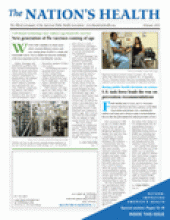The H1N1 outbreak influenza has exposed serious gaps in the nation’s ability to respond to public health emergencies, according to a new preparedness report.
Released in December by Trust for America’s Health and the Robert Wood Johnson Foundation, the report lists state-by-state health preparedness scores based on 10 key indicators that gauge health emergency preparedness capabilities. Nearly two-thirds of states scored seven or lower on those indicators, which include the surge work force ability of public health laboratories, food safety detection and diagnosis, medical reserve corps readiness and hospital preparedness.
“The H1N1 outbreak has vividly revealed existing gaps in public health emergency preparedness,” said Richard Hamburg, deputy director of Trust for America’s Health. “As the second wave of H1N1 starts to dissipate, it doesn’t mean we can let down our defenses. In fact, it’s time to double down and provide a sustained investment in the underlying infrastructure so we will be prepared for the next emergency and the one after that.”
Overall, the report found investments made in pandemic and public health preparedness over the past several years greatly improved U.S. readiness for the H1N1 outbreak. Yet decades of “chronic underfunding” also meant many core systems were not properly prepared.
More than half of states had public health funding cuts while federal preparedness funds were cut by 27 percent since fiscal year 2005, according to the report, putting in jeopardy any improvements made in the wake of the Sept. 11, 2001, terrorist attacks. More than one-fourth of states cut public health funding between fiscal year 2007–2008 and fiscal year 2008–2009.
“All Americans have the right to expect fundamental health protections during public health emergencies, no matter where they live,” said the report, which is an annual accounting of how well-equipped states are to deal with major public health threats.
Infrastructure concerns raised by the report included a lack of real-time coordinated disease surveillance and laboratory testing, outdated vaccine production capabilities, limited hospital surge capacity and a shrinking public health work force.
Recommendations for improving preparedness are outlined in the report and touch on ensuring stable and sufficient funding and updating preparedness plans with lessons learned from the outbreak, and increasing accountability and transparency.
“Public health provides essential prevention and preparedness services that help us lead healthier lives,” said APHA member Michelle Larkin, JD, MS, RN, public health team director and senior program officer at the Robert Wood Johnson Foundation. “Without sustained and stable funding, Americans will continue to be needlessly at risk from the next public health threat.”
The report also recommended improving community preparedness by strengthening the ability to “reach out quickly and effectively to high-risk populations, including strengthening culturally competent communications around the safety of vaccines.” It calls for addressing health disparities among low-income and racial and ethnic minority communities, which are often at higher risk during health emergencies.
The full report, “Ready or Not? 2009: Protecting the Public’s Health from Disease, Disasters and Bioterrorism,” as well as a clickable map linking states to preparedness scores, are available at http://healthyamericans.org.
- Copyright The Nation’s Health, American Public Health Association









